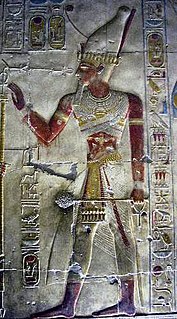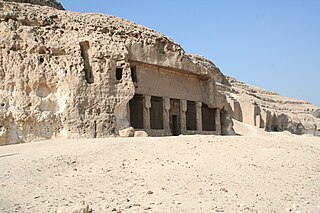Related Research Articles

Hatshepsut was the fifth pharaoh of the Eighteenth Dynasty of Egypt. She was the second historically-confirmed female pharaoh, the first being Sobekneferu.

Thutmose III was the sixth pharaoh of the Eighteenth Dynasty. Officially, Thutmose III ruled Egypt for almost 54 years and his reign is usually dated from 24 April 1479 BC to 11 March 1425 BC, from the age of two and until his death at age fifty-six; however, during the first 22 years of his reign, he was coregent with his stepmother and aunt, Hatshepsut, who was named the pharaoh. While he was shown first on surviving monuments, both were assigned the usual royal names and insignia and neither is given any obvious seniority over the other. Thutmose served as the head of Hatshepsut's armies. During the final two years of his reign, he appointed his son and successor, Amenhotep II, as his junior co-regent. His firstborn son and heir to the throne, Amenemhat, predeceased Thutmose III.

Menmaatre Seti I was a pharaoh of the New Kingdom Nineteenth Dynasty of Egypt, the son of Ramesses I and Sitre, and the father of Ramesses II. As with all dates in Ancient Egypt, the actual dates of his reign are unclear, and various historians claim different dates, with 1294 BC to 1279 BC and 1290 BC to 1279 BC being the most commonly used by scholars today.

Thutmose I was the third pharaoh of the 18th dynasty of Egypt. He received the throne after the death of the previous king, Amenhotep I. During his reign, he campaigned deep into the Levant and Nubia, pushing the borders of Egypt farther than ever before. He also built many temples in Egypt, and a tomb for himself in the Valley of the Kings; he is the first king confirmed to have done this.

Senenmut was an 18th Dynasty ancient Egyptian architect and government official. His name translates literally as "mother's brother."

Heqamaatre Ramesses IV was the third pharaoh of the Twentieth Dynasty of the New Kingdom of Ancient Egypt. His name prior to assuming the crown was Amonhirkhopshef. He was the fifth son of Ramesses III and was appointed to the position of crown prince by the twenty-second year of his father's reign when all four of his elder brothers predeceased him. His promotion to crown prince:
is suggested by his appearance in a scene of the festival of Min at the Ramesses III temple at Karnak, which may have been completed by Year 22 [of his father's reign].

Den, also known as Hor-Den, Dewen and Udimu, is the Horus name of a pharaoh of the Early Dynastic Period who ruled during the First Dynasty of Egypt. He is the best archaeologically-attested ruler of this period. Den is said to have brought prosperity to his realm and numerous innovations are attributed to his reign. He was the first to use the title "King of Lower and Upper Egypt", and the first depicted as wearing the double crown. The floor of his tomb at Umm El Qa'ab near Abydos is made of red and black granite, the first time in Egypt this hard stone was used as a building material. During his long reign he established many of the customs of court ritual and royalty used by later rulers and he was held in high regard by his immediate successors.

Senusret I also anglicized as Sesostris I and Senwosret I, was the second pharaoh of the Twelfth Dynasty of Egypt. He ruled from 1971 BC to 1926 BC, and was one of the most powerful kings of this Dynasty. He was the son of Amenemhat I. Senusret I was known by his prenomen, Kheperkare, which means "the Ka of Re is created."

The Speos Artemidos is an archaeological site in Egypt. It is located about 2 km south of the Middle Kingdom tombs at Beni Hasan, and about 28 km south of Al Minya. Today, the site is a small village known as Istabl Antar.

KV20 is a tomb in the Valley of the Kings (Egypt). It was probably the first royal tomb to be constructed in the valley. KV20 was the original burial place of Thutmose I and later was adapted by his daughter Hatshepsut to accommodate both her and her father. The tomb was known to the Napoleonic Expedition in 1799, but a full clearance of the tomb only was undertaken by Howard Carter in 1903, although it had been visited by several explorers between 1799 and 1903. KV20 is distinguished from other tombs in the valley, both in its general layout and because of the atypical clockwise curvature of its corridors.

Gebel el-Silsila or Gebel Silsileh is 65 km north of Aswan in Upper Egypt, where the cliffs on both sides close to the narrowest point along the length of the entire Nile. The location is between Edfu in the north towards Lower Egypt and Kom Ombo in the south towards Upper Egypt. The name Kheny means "The Place of Rowing". It was used as a major quarry site on both sides of the Nile from at least the 18th Dynasty to Greco-Roman times. Silsila is famous for its New Kingdom stelai and cenotaphs.

The Red Chapel of Hatshepsut or the Chapelle Rouge originally was constructed as a barque shrine during the reign of Hatshepsut. She was the fifth pharaoh of the eighteenth dynasty of Ancient Egypt and ruled from approximately 1479 to 1458 BC.

The unfinished obelisk is the largest known ancient obelisk and is located in the northern region of the stone quarries of ancient Egypt in Aswan, Egypt.

Neferure was an Egyptian princess of the Eighteenth Dynasty of Egypt. She was the daughter of two pharaohs, Hatshepsut and Thutmose II. She served in high offices in the government and the religious administration of Ancient Egypt.

The stone quarries of ancient Egypt once produced quality stone for the construction of decorative monuments such as sculptures and obelisks. These quarries are now recognised archaeological sites. Eighty percent of the ancient quarry sites are in the Nile valley; some of them have disappeared under the waters of Lake Nasser and some others were lost due to modern mining activity.
Tay was a high official of Ancient Egypt with the main title treasurer. He was in office under Hatshepsut and in the first years of Thutmose III. Tay is only known from three attestations. He appears in a rock inscription on the island of Sehel, in a letter that is dated by context under Hatshepsut and from a stela found on Sinai. The latter inscription is dated to year 25 under king Thutmose III. Tay is shown here standing behind the king. According to the rock inscription on Sehel he was on a military campaign with the queen to Nubia. The inscription also provides the throne name Maatkare, of queen Hatshepsut The exact date of the military enterprise is not known for sure, but may have happened in year 12 of the queen. Tay was therefore in office from about year 12 of Hatshepsut till about year 25 under Thutmose III. Under Hatshepsut there is also attested the treasurer Nehsi. Recently it has been suggested, that the office of the royal treasurer was divided into a northern and into a southern office. According to that, Nehesi was the northern treasurer under Hatshepsut, Tay the southern treasurer.
Wadjetrenput was an ancient Egyptian official with the title of a high steward. He was in office under the ruling queen Hatshepsut. Wadjetrenput is known from several inscriptions, but none of them is dated, making it hard to provide an exact chronological position for the high official within the reign of the queen. He appears on an ostracon found at Deir el-Bahari also naming the official Senenmut. The latter is well known from the reign of the queen, providing evidence that he also lived in her times. He appears in a rock inscription in southern Egypt, near Aswan. The inscription mentions Hatshepsut and king Thutmoses III providing evidence that the queen sent him on mission to quarry stones. On so called name stones he also appears with the title overseer of works in the Amun temple
Djehuty was an Ancient Egyptian official under the ruling queen Hatshepsut. He bore several important titles that testify his high position at the royal court. His main title was overseer of the silver and gold houses. With this title he was the main person in charge of the treasury at the royal palace. He is attested from year 9 to year 16 of queen Hatshepsut. In year 9 he was involved in the queen's expedition to the foreign land called Punt in Egyptian sources. In year 16 he was inlaying the gold for the obelisks of the queen, that were set up in this year. He was buried in a Theban tomb (TT11). From his tomb are preserved two stelae, one of them with a longer autobiographical inscription reporting mainly building activities in Amun temple at Karnak. At the end of his career Djehuty and his family felt into dishonor. His name is most often erased within his tomb. His parents are the lady of the house Dediu and the zab Abty. The names of the parents are erased too, as are the names of other family members.
Djehutyhotep, also called Paitsy, was a Nubian official under Hatshepsut and Thutmosis III. He was chief of Teh-khet and was therefore a governor ruling a region in Lower Nubia for the Egyptian state. In the New Kingdom, Egyptian kings had conquered Lower Nubia. To secure control over the new region they appointed people of the local elite as governors. Teh-khet was a Nubian region that covered about Debeira and Serra. The local governors here formed a family, while the governor proper hold the title chief of Teh-khet. Djehutyhotep's father Ruiu was also chief of Teh-khet. His mother was called Runia. His wife Tenetnub. His brother Amenemhat was also chief of Teh-khet and followed Djehutyhotep in office.
Sememiah was a high ancient Egyptian official of the 18th Dynasty in office under the ruling queen Hatshepsut. His main title was that of an Overseer of the treasuries.
References
- ↑ JJ Shirley: The Power of the Elite: The Officials of Hatshepsut's Regency and Coregency, in: J. Galán, B. M. Bryan, P. F. Dorman (eds.): Creativity and Innovation in the Reign of Hatshepsut, Studies in Ancient Oriental Civilization 69, Chicago 2014, ISBN 978-1-61491-024-4, pp. 205-208.